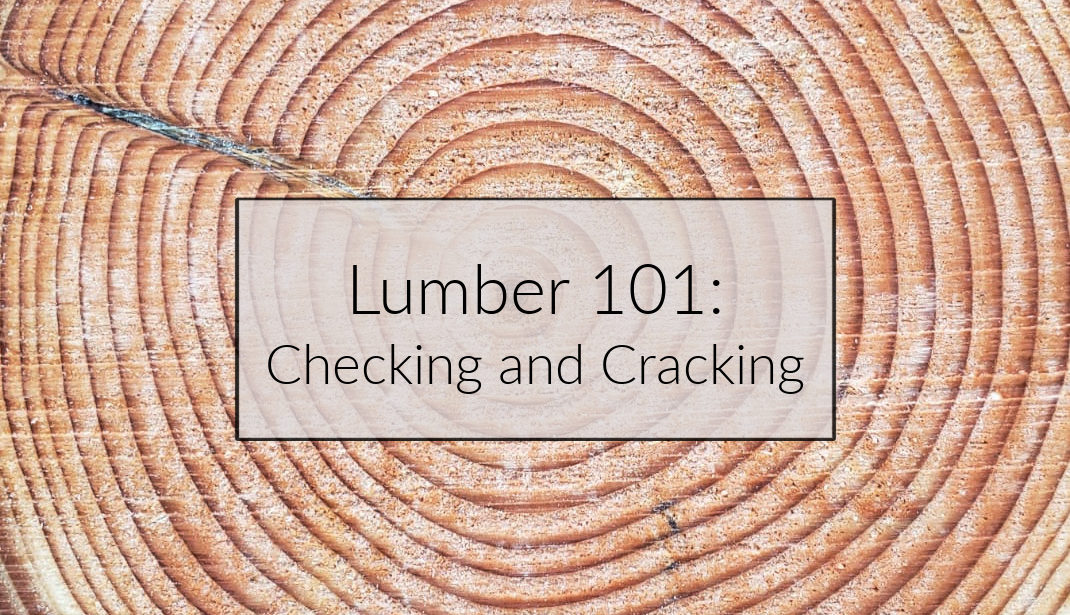
Following up on our post about Green vs. Kiln Dried wood brings us to the next topic: checking, cracking, and splitting. We will cover what it is, why it happens, and how to minimize the effects.
Definitions:
Checks: a “check” is usually a long crack that appears parallel to the grain as the sapwood shrinks around the heartwood (the center of the tree) during the drying process. Checking does not affect the structural properties of a piece of wood, it adds character and rustic appeal to your project!
Shake: shake is the separation of the growth rings. This is almost a “peeling” action that happens when the wood is drying. This usually is an aesthetic problem, not a structural one, unless the shake runs very deep in the timber.
Cracks: cracks, also known as splits, are not a natural occurrence; they usually appear from too much pressure on a piece of wood. Cracks and splits will run perpendicular or on an angle to the grain, this is not structurally sound and should be addressed quickly.
Why Does Wood Check?
Green (wet) wood will naturally dry over time and as wood dries, it will shrink. This causes cracks and splits in the wood, these are called “checks”. There is no way to prevent checks from happening, especially when wood is used in an outside application. Here in Vancouver, BC we see a dramatic difference in temperature and humidity with our seasons. Summers are typically hot and dry, while fall and winter months tend to be quite rainy and humid, this puts a strain on the wood fibres as they absorb and expel moisture.
How to Avoid Cracking?
There is no way to anticipate where a crack will form on a piece of wood, but there are a few ways to help minimize it:
- Avoid direct sunlight on your pieces before installation. When it is hot and sunny, we cover all orders in paper/plastic wrap to protect the pieces from direct sunlight. We recommend keeping the paper wrap placed over the lumber until you are ready for installation.
- Acclimate your pieces to the environment. Depending on the location of your project, you may want to consider slowly acclimating the wood before construction. For indoor projects, lay the pieces out so they have plenty of airflow and allow them to get used to the temperature and humidity of your house. Avoid drastic temperature and humidity changes when acclimating wood.
- Purchase higher grade lumber for your project. For some projects, cracks may not matter at all. Such as vegetable boxes or fencing – you may never notice the cracks develop. If your project is inside your house or a particular feature item, you may want to consider a higher grade. Higher grade or clear lumber has a lower chance of checking due to fewer knots and the straightness of the grain fibres. Vertical grain pieces have a lesser tendency to check because of how the grain runs the length of the board, this is a more expensive option and more difficult to source.
- Securely fasten all pieces of your project. This may seem like a no-brainer, but securely fastening all pieces with appropriately sized screws or nails is very important to keeping your project looking good as new! If a project is fastened with too few screws, the wood might have enough torque to rip the screws right out. Make sure the screws are long enough to bite into a good portion of the wood.
- Use kiln-dried lumber instead. If your project will be indoors, consider using kiln-dried lumber. Since the internal moisture content has been lowered through the process of kiln drying, the lumber is very stable and unlikely to check as it ages. Acclimation is still recommended in this case, but a shorter period is required.
Wood is a natural material, each and every piece of lumber is unique in its grain and knot placement. Green lumber will always have some movement as it dries, this is totally normal. Our team makes it a priority to provide straight lumber for all orders, however we cannot guarantee that your pieces will not change as they dry and adjust to new environments. The photos below are extreme examples to help illustrate the different kinds checks, cracks, and shake that are encountered with wood. These extreme examples are never shipped out to our customers!
If your project requires kiln dried or a higher grade of lumber, please contact us directly to see if we have what you’re looking for or if we can point you in the right direction.